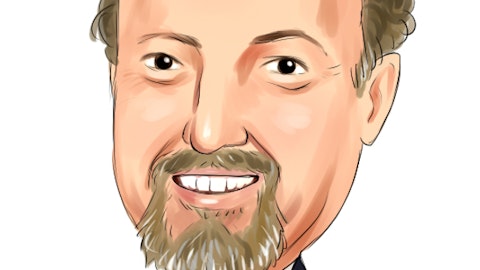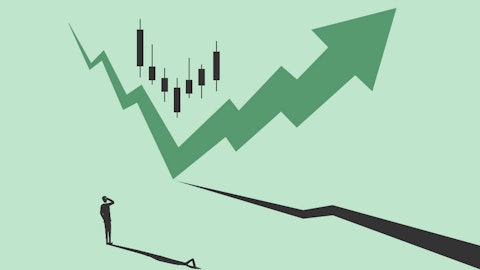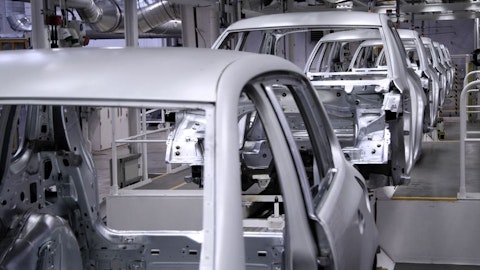Ford Motor Company (NYSE:F) Q3 2023 Earnings Call Transcript October 27, 2023
Operator: Good day, everyone. My name is Gary, and I will be your conference operator today. At this time, I would like to welcome you to the Ford Motor Company Third Quarter 2023 Earnings Conference Call. All lines have been placed on mute to prevent any background noise. After the speakers’ remarks, there will be a question-and-answer session. [Operator instructions] Please note this event is being recorded. At this time, I would like to turn the call over to Lynn Antipas Tyson, Executive Director of Investor Relations. Please go ahead.
Lynn Antipas Tyson: Thank you, Gary. Welcome to Ford Motor Company’s third quarter 2023 earnings call. With me today are Jim Farley, President and CEO; John Lawler, Chief Financial Officer; and Peter Stern, President, Ford Integrated Services. Also joining us for Q&A is Marion Harris, CEO of Ford Credit. Today’s discussions include some non-GAAP references. These are reconciled to the most comparable U.S. GAAP measures in the appendix of our earnings deck. You can find the deck along with the rest of our earnings materials and other important content at shareholder.forward.com. Our discussion also includes forward-looking statements about our expectations. Actual results may differ from those stated. The most significant factors that could cause results to differ are included on Page 20. Unless otherwise noted, all comparisons are year over year, company EBIT, EPS, and free cash flow are on an adjusted basis. Now, I’d like to turn the call over to Jim.

A customer smiling delightedly after driving away in their new car from the automotive retail shop.
Jim Farley: Thank you, Lynn. Hello, everyone, and thanks for joining us today. I wanted to start by thanking the Ford team who worked tirelessly and creatively over the past several months to reach a tentative agreement with the United Auto Workers. I’m so pleased for our employees. This week, I was able to visit each of the struck plants. I was impressed by their preparation for start-up, and the feeling I got is people just want to get back to work. Once the deal is ratified, we will provide all of you a deeper look at the contract and its impact on our business. Right now, we’re focused on restarting three important assembly plants, calling back more than 20,000 Ford employees to work, supporting our suppliers as they restart, and shipping lots of Super Duties, Explorers, and Broncos to our customers.
It’s been a challenging situation, for sure. Matter of fact, our business is never short of challenges, especially right now with the evolution of the EV market and new global competitors from China, as well as the technology disruptions. But I am more excited and motivated than ever. Our team is making tremendous progress every day toward building a Ford that thrives at the intersection of fantastic and iconic vehicles, terrific brands, and especially software and services. We are deep into the development of our future software platforms, which provide the foundation for rapid innovation and a profitable new software and services business and constantly improving experiences for our customers. We believe Ford+ is the right strategy to win in this constantly evolving industry transformation.
We’re building a more dynamic and less cyclical company, and we are nowhere near peak profitability. We have the right team and talent, and we are in the process of building a culture of excellence and execution. In a moment, John will detail the quarter, which I would call mixed. The strength of our products and revenues and businesses defined definitely came through in our results. But at the same time, we were never negatively impacted by the strike, and our cost and quality remain a drag on our business. Now, last week, we made some important leadership changes. Kumar Galhotra as COO will now control the key levers for transformative change in our industrial system, powertrain, ICE, and hybrid products, vehicle hardware engineering, cycle plan, quality, supply chain, and manufacturing, and work in tandem, of course, with Doug Field, chief EV, digital, and design officer, to move us forward.
I believe this will accelerate our progress on cost and quality, and I hope we get into that in the Q&A. These are my top two priorities. Overall, we see – we are seeing the clear benefits of creating three distinct growth businesses now with Ford Blue, Model e, and Pro. The story of Ford Blue comes down to product strength. Incredibly strong brands like Mustang and Bronco and Raptor, they have durable pricing power and real choice between gas and hybrid. Ford is America’s best-selling brand now through three quarters, even with the effects of the strike, and we have a wave of new products coming in the next few months, the new F-150, the Ranger, a brand-new Explorer, and Expedition and Navigator. In fact, close to 60% of our volume and revenues in the U.S. will be new and refreshed next year.
I am so thankful we have kept our foot on the gas to freshen our ICE and HEV products as we enter a changing market. In Europe, we bring out new versions of Puma and Kuga or high-volume gas and hybrid SUVs, and the Ranger pickup and our Everest SUV that’s based on it continued to gain share in international markets. So, bottom line, Ford Blue will be strong and a growing business for years to come. We also remain bullish on Model e and our EV future, but clearly, the market is moving – is a moving target. I’m optimistic because customers are smart and are rational, and for many of them, EVs are a great choice. I’ve been spending a ton of time in our product development center with both Doug Field and Alan Clarke, and you should see the Gen 2 and Gen 3 EVs we’re working on.
Our Gen 2 all-new full-size pickup truck, for example, is one of the most thrilling vehicles I have ever seen in my career. Let me be specific. Stunning performance like no truck has ever performed, building unexpected innovation for truck customers far beyond the normal truck attributes, a super flexible cabin that feels like a lounge or a tiny office. Take the wheels off this truck, and it’s still a mind-blowing product and a digital experience that totally is immersive and personalized. I’d take this truck seven days of the week over a Cybertruck. A great product is not enough in the EV business anymore. We have to be totally competitive on cost. Tesla actually gave us a huge gift with a laser-focus on cost and scaling the Model Y. They set the standard, and we are now making real progress on our second- and third-cycle EVs that are in the midst of being developed today as we get closer to the introduction.
While our Gen 2 EVs were targeting to deliver an EBIT margin comparable to ICE by 2026, the dynamic changes in the market, pricing, adoption rates, regulations are forcing us to further reduce the cost of our EVs. The key levers to deliver this competitive cost structure are scaling, vertical integration, and batteries. So, let’s double-click on each of these three. On scaling, this is much more than building new facilities or scaling high-quality batteries or thermal propagation. We’re leveraging digital prognostic capabilities in our manufacturing lines to improve quality. We are also reducing complexity, and we are optimizing our vehicle design and engineering for manufacturability. Yep, we’re designing these vehicles for our manufacturing team.
On vertical integration, this is the most fundamental change. We are insourcing batteries, inverters, scaling production of our drive units and gearboxes, and designing and producing unit castings in-house at Ford. In addition, on our next-generation utility vehicles, vertical integration will increase by nearly 50%. This level of integration, along with the new zonal electric architecture and designing in-house modules and battery cell to structure, will allow us to significantly reduce material cost. Now, none of this will be easy, and it has some risk, and you’ve seen our competitors struggle as they build out and ramp up these capabilities. So, we are so glad we started years ago on this journey. And finally, batteries. They’re the single biggest cost component of any EV.
Our more energy-efficient Gen 2 products, we use extreme aero to get the very smallest batteries possible for competitive range. And with our LFP batteries, we’ll have the lowest or one of the lowest-cost batteries assembled in the U.S. Our overall EV priorities are very clear, disciplined capital allocation and investment that drives profitable, high-returning and enduring EV business, and we will constantly balance growth, scale, and profitability. These great EVs will be paired with modern shopping and buying experiences that are transparent or have non-negotiated pricing and a streamlined checkout and delivery that will come to life early in 2024. And this is also a significant cost reduction. I saved Ford Pro for the last because it’s a massive driver of Ford’s growth and profitability.
Our competitors seem to be trying to cut and paste our strategy, but the reality is the moats we’ve built over many decades for our Pro business won’t be easy to cross. The network of literally thousands of local outfitters across Europe, North America, and China and customer-driven engineering we have for vehicles like F-Series and Transit is formidable across all those regions. Our commercial order banks are healthy. This may be a surprise to everyone. We see a large backlog of infrastructure projects. Thank you, 5G and roadworks. And we have very loyal customers. Fleet orders, for example, for the 2024 Super Duty are coming in faster than last year’s orders, and we expect strong demand to continue as more customers recognize what Ford has to offer in total.
In addition to the new Super Duty, we are preparing to launch the new Transit Custom in Europe. Think of this product as a Super Duty for Europe. It’s a best-selling vehicle in the UK, not the best-selling commercial vehicle, the best-selling vehicle and the leading one-ton van in Europe. And it’s a key profit pillar for Europe and one of the reasons why we stayed there. When it comes to software and services, Ford Pro is the tip of our digital spear. Customers know and trust our vehicles, of course. And we’re building on this with software-driven services that provide businesses with data insights, vehicle access, even vehicle control, and functionality. This helps them drive productivity and efficiency in their fleet operations. And I’ve asked Ted Cannis to also lead our large and profitable aftersales business.
His focus will increase our post-warranty service business and profitability. He’s already adding mobile service capability and delivering an effortless experience to both commercial and retail customers. There is so much upside in this aftersales, parts, repair, and collision business, especially with Ted leading it and for Ford Pro. I want to briefly touch on China where our strategy to turn our business around is gaining traction. The restructuring of our EV business there is nearly complete, and the internal combustion engine business is now profitable. We are now expanding China’s role to a profitable export hub, including Ford Pro. We’ve already exported a record number of vehicles so far from China to markets like Mexico, South America, and Asia.
There is so much more opportunity ahead for us. Yes, the China market is extremely competitive in the middle, but Ford can succeed by staying asset-light, partnering where it makes sense, and competing in very narrow segments where we can clearly win like commercial vehicles, off-road vehicles, large SUVs, and Lincoln. Finally, I’m so pleased to have Peter Stern on today to share more about our newly formed Ford Integrated Services, which will create and market valuable software-enabled customer experiences across Blue, e, and Pro. Now, this is transformational because the cornerstone of Ford+, the plus in our plan, is creating incredible customer services and experiences enabled by not just hardware but software. There’s simply no one in the world better able than Peter, who is the driving force behind services at Apple, to build this strategically vital business for us.
Peter, over to you.
Peter Stern: Thanks, Jim. I’ve spent my career creating new customer experiences and launching businesses at the intersection of hardware, software, and services. And I came to Ford because this company puts that kind of innovation at the center of its long-term strategy. As you said, it’s literally the plus in Ford+. Now, over two months in, I’m even more excited to be here and to be part of this exceptional team that’s working together to bring the Ford+ plan to life for our customers, employees, and shareholders. Our vision for integrated services is to transform every aspect of the Ford customer experience across our three segments. We’re making our vehicles even more connected, convenient, productive, secure, and exhilarating.
Over the past couple of months, we’ve identified a portfolio of services that will improve our customers’ lives and businesses by building on our industry-leading early successes with Ford Pro Intelligence and BlueCruise. This portfolio will elevate the Ford brand and introduce us to millions of new customers who may have never considered a Ford before. It will drive new high margin, cyclical recurring revenue streams for Ford and result in stronger relationships with our customers. And we’ll do this while adhering to the values that distinguish Ford from our competitors, like our respect for customer privacy, safety, and very importantly, choice. Whether you choose to add our services or not, you’ll have an amazing vehicle. Our momentum around software and services is building fast.
Here are three examples. First, Ford Pro Intelligence builds on Ford’s industry-leading share in the commercial vehicle space by making the people who drive our vehicles even more productive and by reducing total cost of ownership. Adoption of vehicle telematics, fleet management, and charging optimization were up 20% sequentially in the third quarter, and our average revenue per subscription was up nearly 10% over the past six months, both contributing to strong revenue growth. And we’re still in the early stages of our rollout. We ended the quarter with 476,000 paid subscriptions for our commercial solutions, a jump of nearly 50% year over year. And we have an ambitious product road map for Pro. For example, over the next few weeks, we’ll launch the Ford Pro dashcam.
This product uses machine vision and in-vehicle intelligence to detect in-cab and on-road events, simplify fleet operations, and encourage safer driving. While we’re still early in our journey, Pro Intelligence is an area that we’ll continue to expand and drive value for both our customers and Ford. Second, in September, we announced that the 2024 F-150 will be the first vehicle available in North America with Ford Stolen Vehicle Services. This is a fully integrated theft prevention and recovery service that provides unique features like inclination and movement alerts. So, you get notified if your truck is jacked up or moved while the engine is off. And third, BlueCruise is one of the most consequential consumer applications of artificial intelligence in the world today.
Some of you experienced our last version at Capital Markets Day. If you haven’t felt what it’s like to take your hands off the wheel and your foot off the gas and let BlueCruise take over steering, acceleration, and braking, please visit a Ford dealer, so we can demonstrate it. Launch to date, our vehicles have been driven hands-free for 125 million miles. That’s the equivalent of 500 trips to the moon, which I imagine would be largely hands-free as well. Real-world driving data from Mustang Mach-E vehicles using BlueCruise shows a more than 10 times reduction in lane departures compared with unassisted driving. And for the second time in a row, BlueCruise was just rated the best hands-free system on the market, and this was based on BlueCruise 1.0. BlueCruise 1.3 is rolling out now and adds lane change support and other refinements that keep drivers in hands-free mode, on average, five times longer than version 1.0. Our technology team, led by my partner, Doug Field, is the best in the business, and BlueCruise is the proof.
Despite these encouraging successes, what we’re about to do in Integrated Services won’t be easy. Our multi-year playbook depends on our next-generation vehicles that are even more connected. We must also round out our customer-centric portfolio of services and evolve our customer relationship management technologies. Our dealers are a key competitive advantage for Ford, and with them, we need to make it easier to become and stay a services customer. We need to build a relationship centered around the customer, not the vehicle, because in the services space, the sale of the vehicle should be the beginning of a beautiful long-term relationship with our customers. And that necessitates not only new people, processes, and technologies but also new measures of success.
So, as we progress in our services evolution, you’re going to hear us talk about key metrics like addressable units in operation, attach rates, and average revenue per subscription. And as we move each of these levers in the context of a low-variable cost, high-margin service business, it will have a multiplicative effect on profits. There’s incredible value to be unlocked here for our customers and for Ford, and I’m proud to be a part of the team making that happen during this pivotal moment in our history. John, over to you.
John Lawler: Thanks, Peter. Through the first three quarters, we delivered 9.4 billion in adjusted EBIT, a strong result that is indicative of our underlying run rate of the business. Now, given our year-to-date performance, we were on track to comfortably deliver our full-year adjusted EBIT guidance of 11 billion to 12 billion. With that said, the UAW strike created significant uncertainty regarding our full-year results, and even though we have reached a tentative agreement and our employees are starting to return to work, we have withdrawn our guidance for the year. This is in part because of the continued disruption in the industry with the ongoing strikes, the follow-on impact to our shared supply base, the ramp up of production in our plants and at our supplier partners, as well as other ancillary effects.
And to provide some context, in the third quarter, the strike had an EBIT impact of roughly $100 million, and so far, the strike has trimmed about 80,000 units from our plant. This would reduce 2023 EBIT by roughly 1.3 billion. Once we have a ratified agreement and begin to ramp operations, we will be in a better position to update you on our full-year guidance. So, let me now turn to our third-quarter results, which was once again – it once again showed our Ford+ plan in action and the benefits of our diversified portfolio. Our leading Pro business and resilient ICE and hybrid products continue to deliver solid results that more than offset the investments we are making in our EV future. Our revenue remains strong, up 11%, reflecting a product lineup that resonates with customers, driving higher net pricing that remains resilient.
Whole sales were flat, dampened by supply constraints affecting both F-Series and Transit production, additional unit holds for quality assurance, and the first UAW work stoppage for Ford in almost 50 years. Adjusted EBIT in the quarter was 2.2 billion with a margin of 5%. Both improved year over year. However, costs increased, underscoring the fact that we still have more work to do, especially on warranty expense and material cost. Adjusted free cash flow was 1.2 billion in the quarter, down year over year, driven by unfavorable working capital. Through the first nine months, we generated 4.8 million of adjusted free cash flow resulting in a conversion rate of 51%, in line with our target range. Our disciplined capital allocation continues to drive strong free cash flow, which will be critical as we adjust our spending to match the pace of EV adoption.
We ended the quarter with over 29 billion in cash and 50 billion in liquidity, one of our strongest quarters ever, and this includes the new 4 billion contingent liquidity facility we put in place in August to help withstand uncertainties in the present environment. Now, turning to our customer-focused segments. Ford Pro generated EBIT of 1.7 billion and delivered a strong double-digit margin of 12%. Both metrics improved, driven by our Super Duty and Transit franchises that helped deliver a 16% improvement in revenue that’s reflecting strong demand and continued pricing power. In addition, we are launching a new version of our flagship product in Europe, the Transit Custom, which, along with the new Super Duty and F-150, will give Pro its freshest vehicle lineup in years.
We also continue to see strong growth in both our new software subscriptions and mobile repair orders, up roughly 50% and 200%, respectively, for the quarter. Regarding Model e, our EV start-up incurred 1.3 billion of losses in the quarter, reflecting continued investment in our next-generation products and a more challenging market for our Gen 1 products. Given the dynamic EV environment, we are being judicious about our production and adjusting future capacity to better match market demand. For example, we have taken out some Mustang Mach-E production, and we are also slowing down several investments, including making a decision with SK On to delay the second BlueOval SK JV battery plant in Kentucky. And we have also said we are evaluating our BlueOval Battery Park Michigan plant to determine the best path forward.
In fact, all told, we have pushed about 12 billion of EV spend, which includes CapEx, direct investment, and expense. The ultimate success of our EV transition will be driven by our Gen 2 and Gen 3 products, which will be cost-optimized and guided by the learnings of our first-generation vehicles that are currently in the market. Turning to Ford Blue. In the third quarter, we delivered EBIT of 1.7 billion, up 300 million, driven by lower commodity costs and higher net pricing that more than offset higher warranty costs. The higher warranty was driven by recalls and higher per unit repair costs due to inflation. Importantly, Blue continues to be profitable in all regions with a strong, fresh portfolio poised for continued global success. Hybrids also continue to be a success, a strategy we’ve had in place now for almost two decades.
We are the clear leader of the hybrid pickup truck segment in the U.S, thanks to Maverick and F-150. We expect to extend its lead next year when we introduce our refreshed 2024 F-150 with more advanced technologies. The F-150 Powerboost hybrid not only offers a 25% improvement in CO2 emissions, but on average, they have more – they are more profitable than our highest-volume gas powertrains. And hybrids aren’t just limited to North America as we are launching a Ranger for Europe and IMG next year. Ford Credit generated EBIT of 358 million. As expected, our results were down year over year, reflecting lower lease residuals and financing margin and the non-reoccurrence of derivatives market valuation gains. Credit loss performance remains strong and below our historical average but continues to normalize.
Auction values remain strong but are down sequentially, in line with our expectations. Finally, turning to software and services. We continue to see sustained quarter-over-quarter growth in subscriptions across all our business segments and, most importantly, at gross margins of around 50%. And our next-generation digital platform will enable a step function change in capability, allowing us to scale and deliver value to both our retail and commercial customers even faster. And as Peter highlighted, as we continue to build out our capabilities here, we expect it to be a significant source of future value creation. In closing, there’s obviously a tremendous amount going on in our business, but I’m confident in our Ford+ plan and the underlying run rate of our business.
So, that wraps up our prepared remarks. We’ll use the balance of the time to address what’s on your minds. Thank you, and operator, please open the line for questions.
See also 17 Largest Media Companies in the World in 2023 and Top 20 Most Expensive Cities To Live In California.
Q&A Session
Follow Ford Motor Co (NYSE:F)
Follow Ford Motor Co (NYSE:F)
Operator: We will now begin the question-and-answer session. [Operator instructions] Our first question today is from Adam Jonas with Morgan Stanley. Please go ahead.
Adam Jonas: Thanks, everybody. So, John, I know you pushed out the 12 billion of the direct and capital investment and other expenditure on EVs, but I guess I’m saying – I’m interpreting that as just temporary, that you still plan on spending it. So, my question is, how long can you keep allocating 10 billion a year, round number, to EVs?
John Lawler: Yes. So, Adam, we’re going to match demand and capital needed to meet that demand. You know, the first step here is given the flatter growth curve that we’re seeing relative to what the industry expected and we expected, we’ve made this decision to push out 12 billion of capital expenditures, but it doesn’t mean that we’ll actually go ahead and pull the trigger on it if we don’t need to. And we’re going to look at the overall EV business and be balanced about that. There’s a lot that’s going to change between now, in ‘26, and ‘30, and we’re going to adjust appropriately. So, it’s something that’s going to adjust as we move and how that business develops, and we’ll adjust that capital allocation appropriately. And we’ll change our strategy and make different decisions as well. And one of the other things I’d say is that – well, I’ll pass it over to Jim because Jim has something he wants to say.
Jim Farley: Hey, Adam, thank you for your question. I just want to emphasize the importance of our Gen 2 and Gen 3 products because they’re very transformation in our profitability in EV. You know, we’ve learned a lot in Gen 1. We’ve reduced the material costs. We’ve got the learning loop on the software. We learned how to scale batteries. We have the LFP battery now. We’re starting to ship to customers, but there’s only so much we can do on Gen 1. On Gen 2, I said – as I said, we have a totally different approach from aero vertical integration designed for manufacturability. And there’s a lot of other things we can do beyond allocating less capital to battery plants, for example. We’ve learned a lot about derivatives like rally.
We’re going to push services a lot more like Level 2+, Level 3 autonomy. And we really plan on even redesign or improving the scale of a components by working with other companies. And the other big breakthrough is going to be which we’re designing in parallel the Gen 3 products where we use the battery as a structural member of the vehicle. We go to low-cost sourcing, go to smaller vehicles. We maximize unit casting even more than we are and radical cost reduction in our distribution. I think the other thing that’s important to understand about Ford’s strategy on EVs is Pro. We actually followed a very different strategy for Pro using a multi-energy platform. So, we didn’t bet on pure electric vehicles for Transit, for example, and we’re now launching the Transit Custom in Europe, and that has diesel gas, and it will have eventually hybrid and pure electric.
That’s a very different bet in our Pro. We’re even starting to export Pro vehicles from China to develop markets around the world that are pure electric. And that part won’t change our product strategy.
Adam Jonas: Appreciate that, Jim. Maybe just a follow-up. On hybrids, you pointed out in the prepared remarks the growth there, and I think you’ve made comments that technology is something you want to lean in on more as a transition. Not that you won’t continue to sell your Gen 1 EVs, but that there is just real demand for hybrids. Can you refresh us as you kind of turn that dial back up on hybrids categorically, how that – how the margins on those products might compare to your ICE – your normal ICE margins? Is it accretive? Is it kind of in the ballpark? I didn’t know if there was any kind of sacrifice or gap there between hybrid and the normal pure ICE. Thanks.
John Lawler: Yes. You want me to jump in, Jim?
Jim Farley: Yes.
John Lawler: There’s added costs as you’d expect for the battery and the motors, etc. But if you look at – let’s just take F-Series, for example. If you take the hybrid on average, they have a higher margin than our highest-volume gas versions because of the mix and what we have in the vehicle and the pricing we can get for the hybrid technology and the fuel efficiency that comes along with that. And one of the things we learned about hybrid, because we’re executing very differently than our first-gen hybrids, is we have Pro power on board. We have a lot of other attributes that people are willing to pay for, like F-150 powering a jobsite or your house as back up energy. That’s another advantage of having those batteries that maybe some of our competitors haven’t had the same pricing power.
The F-150 now, a hybrid, is up 40% year over year, and we think the new F-150 new hybrid will be 20% mix, and it may be the best-selling hybrid in the United States. So, our hybrid strategy is a little different than our competitors because the work cycle for our products are different, but hybrid has a really big place. We’re trying to challenge ourselves, Adam, to execute hybrids, so they do more than just propel the vehicle for pricing power.
Adam Jonas: Thanks, Jim. Thanks, John.
Operator: The next question is from John Murphy with Bank of America. Please go ahead.
John Murphy: Good afternoon, guys. Just a first question, Jim, on warranty and an accelerated – sort of headwind, on a year-over-year basis, accelerated a bit in the quarter. But if I look at the full-year numbers, even if we added back this – I think it’s Slide 32. If we added back the 1.7 billion on warranty to the 9.4 billion in EBIT you’ve done year to date, you’d already even be in your range in the first three quarters of the 11 billion to 12 billion in EBIT you’d been talking about before. So, I mean, it’s a major issue here for the numbers and results in cash flow. What’s going on, and how are you going to get a handle on this and reverse this hopefully in the next year or two?
John Lawler: Yes. So, Adam, that’s exactly right. One of the things we’re – sorry, John. One of the things we’re seeing is that it’s not just the quality issues which are an important piece of this, and I think Jim wants to comment on that. But we’re also seeing tremendous inflation from the dealers on the repair costs. And that’s driving quite a bit of it. If you look at the increase that we had in the quarter for the warranty on a year over year, the 1.2 billion, and say that about 300 million of that was inflationary costs and roughly 900 million was the issue with warranties. So, that’s what we’re seeing there. And the issue around the quality that’s something that Jim’s going to be going to cover here.
Jim Farley: Hey, John, again, thanks for your question. I want to slow it down a little bit and explain kind of our operational headwinds, not just quality but cost as well, and give a little bit of context and maybe highlight some of the stuff we’ve done but the work we have to do. A couple of years ago, when we started as a management team, the team that’s doing cost and quality is same team, and we have a lot of revenue power in the company. But we also have a lot of technology, and that technology that we rolled out like cameras before our competitors, it puts a huge burden on that electric architecture with a lot of extra modules and software. We definitely had the largest complexity customer-facing of any brand, and we also ran the business on products instead of platforms and systems.
Our engineers and supply chain team did not have competitive tools like IT systems and parts release IT. We weren’t cooperating with the suppliers the right way on cost reduction. We kind of negotiated them every year, but we weren’t really getting into redesigning the parts and getting the complexity out of the suppliers’ manufacturing system. We didn’t really use a lot of strategic sourcing. So, we had a lot of concentration, our suppliers, and lack of leverage. We had inconsistent application within our manufacturing system for our QOS. So, some plants were fantastic like in China and Mexico. All the plants were completely uncompetitive and run differently. And we traveled hopefully on a lot of the launches. The gateways, we would have some issues, and the team had, kind of a hero mentality to try to close them out at the end of the launch, and we would get in trouble.





